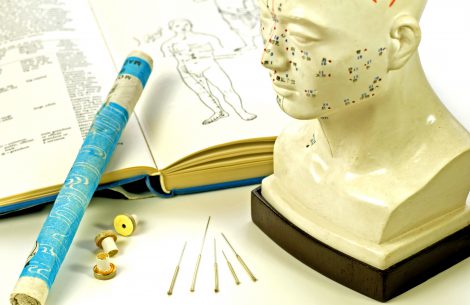In acupuncture, pins are placed in the body in attempts to ease pain, but how does acupuncture accomplish that, and what about its impact?
The trail goes to the nervous system and how acupuncture influences brain activity.
Acupuncture points stimulate the central nervous system, it seems clear. From there the impact cascades: it releases chemicals into the brain, the spinal cord and muscles, in a whirl that may stimulate the body’s natural healing abilities and effectively impact on pain.
Studies show that acupuncture has been used for various nerve-related disorders, such as cardiovascular diseases, epilepsy, anxiety and nervousness, circadian rhythm disorders and other issues. Acupuncture impacts parasympathetic nervous activity. That system is part of the nervous system, of course, but it regulates rest and digestive system and conserves energy.
Chemical Releases
Acupuncture also allows the brain to release neuropeptides, which are molecules that allow neurons and effector cells to communicate into the central nervous system, according to bustle.com. That also can help relieve pain and spur self-healing. Endorphins, another brain produced chemical, can also help manage pain.
A paper in the Journal of Acupuncture and Meridian Studies supports a key effectiveness of acupuncture is how it influences the nervous system, specifically around musculoskeletal pain.
The report notes: “Key findings support acupuncture’s ability to alter pain-related connectivity in the central nervous system.” The current findings “strengthen the evidence from previous systematic reviews indicating that acupuncture can modulate activity in multiple cortical and subcortical brain areas,” according to the study.
Chronic Pain
Experts also have examined the brain response to acupuncture, particularly for people with chronic pain.
It resulted in positive findings that focused on reversing abnormal plasticity, and alterations in brain areas. Normal plasticity refers to how neurons adapt to environmental changes.
In China, physicians have been using acupuncture for thousands of years, with the premise that the needles in the skin restore the flow of healing qui energy. Specifically, acupuncture involves insertion of thin needles into the muscle at specific acupuncture points placed along what is known as meridians for a variety of conditions.
It is estimated that nearly 40 million adults in the U.S. are plagued by persistent pain, and the National Institutes of Health says that pain impacts many more people in the U.S. than many other major illnesses, such as cancer and heart disease.
Variations of Pain
Biologically, pain has different classifications, such as nociceptive pain, considered the most common type of pain, and the nervous system’s response to harmful stimuli, inflammatory pain, involving an inflamed organ, and neuropathic pain, caused by lesions involving the nervous system.
While medical treatments often depend on opioids, there are increasingly more people upset and worried about potential side effects, including addictions. As a result, people seek alternative treatments, such as acupuncture. In addition, many physicians feel they don’t have adequate training in pain management.
Like many issues, acupuncture is controversial because of a lack of universally accepted biological mechanism, theories of use and efficacy, and conflicting views of evidence. Although many people abide by acupuncture, it is not free of controversy and much debate about its effectiveness. Yet more studies are showing its effectiveness and discuss the need for even more academic insight.
References:
- American Academy of Family Physicians: Research Finds Acupuncture Effective for Chronic Pain. Retrieved from: https://www.aafp.org/news/health-of-the-public/20180521acupuncture.html
- Santiao, MV, Tumilty, S, et al. Does Acupuncture Alter Pain-related Functional Connectivity of the Central Nervous System? A Systematic Review. 2016. Journal of Acupuncture and Meridian Studies. Vo. 9, Issue 4. Pages 167-1777. https://doi.org/10.1016/j.jams.2015.11.038
- Pacific College of Oriental Medicine. Acupuncture’s Impact on Opioid Addictions and Pain Management. Retrieved from: https://www.pacificcollege.edu/news/blog/2018/02/06/acupunctures-impact-opioid-addictions-and-pain-management
- Li, Q, Shi, GX, et al. Acupuncture Effect and Central Autonomic Regulation. 2013. Evidence-based Complementary and Alternative Medicine. Doi: 10.115/2013/267959.
- University of Miami Health News. Why Acupuncture Works – Health News. 2018. Retrieved from: https://news.umiamihealth.org/en/why-acupuncture-works/
- US San Diego School of Medicine. Center for Integrative Medicine. How Acupuncture Can Relieve Pain and Improve Sleep, Digestion and Emotional Well-being. 2018. Retrieved from: https://medschool.ucsd.edu/som/fmph/research/cim/clinicalcare/Pages/About-Acupuncture.aspx
- Pacific College of Oriental Medicine. Acupuncture’s Impact on Opioid Addictions and Pain Management. 2018. Retrieved from: https://www.pacificcollege.edu/news/blog/2018/02/06/acupunctures-impact-opioid-addictions-and-pain-management
- Science Daily. Parasympathetic nervous system. 2018. Retrieved from: https://www.sciencedaily.com/terms/parasympathetic_nervous_system.htm
- Kyli Rodriquez-Cayro. 7 Ways Acupuncture Changes Your Brain, According to Science. 2018. Retrieved from: https://www.bustle.com/p/7-ways-acupuncture-changes-your-brain-according-to-science-8860049
- Paul Ingraham. Does Acupuncture Work for Pain? 2018. PainScience.com. Retrieved from: https://www.painscience.com/articles/acupuncture-for-pain
- Johns Hopkins Medicine. Acupuncture. 2018. Retrieved from: https://www.hopkinsmedicine.org/healthlibrary/conditions/complementary_and_alternative_medicine/acupuncture_85,p00171

